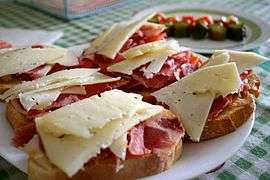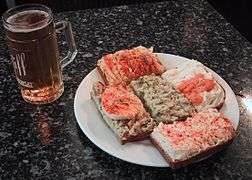Open sandwich
|
Smørbrød, smørrebrød or smörgås, a Scandinavian open sandwich at a cafeteria in Norway | |
| Alternative names | Open-face sandwich, open-faced sandwich, tartine, bread platter |
|---|---|
| Type | Sandwich |
| Main ingredients | Bread, topping |
| Variations | Many variations exist |
|
| |
An open sandwich, also known as an open-face/open-faced sandwich, bread platter[1] or tartine,[2] consists of a single slice of bread with one or more food items on top.
History
During the Middle Ages, thin slabs of coarse bread called "trenches" (late 15th century English) or, in its French derivative, "trenchers", were used as plates.[3] At the end of the meal, the food-soaked trencher was eaten by the diner (from which we get the expression "trencherman"), or perhaps fed to a dog or saved for beggars. Trenchers were as much the harbingers of open face sandwiches[4] as they were of disposable crockery.
A direct precursor to the English sandwich may be found in the Netherlands of the 17th century, where the naturalist John Ray observed that in the taverns beef hung from the rafters "which they cut into thin slices and eat with bread and butter laying the slices upon the butter".[5] These explanatory specifications reveal the Dutch belegd broodje, open-faced sandwich, was as yet unfamiliar in England.
In various countries
.jpg)

An open sandwich is a slice of fresh bread, with different spreads,[6] butter, liver pâté, cheese spreads, cold cuts such as roast beef, turkey, ham, bacon, salami, beef tongue, mortadella, head cheese or sausages like beerwurst or kabanos, and vegetables like bell peppers, tomatoes, radish, scallion and cucumber.
Open sandwiches like this are consumed in France, Denmark,[7] Norway,[8] Sweden,[9] Austria and Germany,[10][11] the Czech Republic,[12] Hungary,[13] the Netherlands,[14] Poland as well as other parts of Europe, and North America as a regular breakfast and supper food item. The American tongue toast is offered as an entrée for breakfast, lunch, and supper and as an hors d'œuvre for formal parties.
In former Czechoslovakia a popular type of open sandwich is called obložené chlebíčky (pl., sg. obložený chlebíček) - slant ways cut slice of veka (long narrow white bread) spread with butter and/or with various combinations of mayonnaise salads and hard boiled egg, cheese, ham, salami, smoked fish (salmon or sprats or pickled herring), tomato, pickled cucumber, lettuce, raw onion or other vegetable, etc.[12]
Open sandwich is the common, traditional sandwich type in the Nordic countries,[15][16] Estonia, Latvia, Lithuania, the Netherlands, Russia, Poland, Ukraine, where it is typically eaten at breakfast, lunch, supper, or as a snack. In Finland the sandwich is called voileipä, and in Estonia similarly võileib, which also means "butter bread".
The Scandinavian open sandwich (Danish: smørrebrød, Norwegian: smørbrød, Swedish: smörgås or macka) consists of one piece of buttered bread, often whole-grain rye bread (Danish: rugbrød, Swedish: rågbröd), topped with, for instance, cheese, cold steak, shrimps, smoked salmon, caviar, hard boiled eggs, bacon, herring, fish fillets, liver pâté (Danish: leverpostej, Norwegian: leverpostei Swedish: leverpastej), and/or small meatballs. This is typically complemented by some herbs and vegetables such as parsley, cold salad, thinly sliced cucumber, tomato wedges and/or pickled beets etc. on the same slice of bread.[15][17]
A condiment, such as mayonnaise, or mayonnaise-based dressing is also often included in some form.[12] An old traditional replacement for butter on a piece of bread with herring is pig fat. There are many variations associated with the smørrebrød/smørbrød/smörgås and there are even special stores, cafés and restaurants (especially in Denmark) that specialize in them.[16][18][19]
The Dutch and Flemish Uitsmijter consists of one or more slices of bread topped with fried eggs (one per slice of bread), and can be accompanied by slices of cheese and/or meat (roast beef or ham). The dish is often served as a hearty breakfast. Sweet toppings are commonly used for breakfast in the Netherlands and Belgium: e.g. sprinkles, vlokken, or muisjes, next to the more widespread peanut butter, honey, jam, and chocolate spread.[14]
In Great Britain, open sandwiches are rare outside of Scandinavian delicatessens. Instead, there is "on toast" (e.g., cheese on toast). However, this is not considered a sandwich. The open sandwiches found in Great Britain are the Welsh rarebit[20] and the Scotch woodcock, an open sandwich served historically at the colleges of the University of Cambridge and University of Oxford and in the refreshment rooms of the House of Commons of the United Kingdom as late as 1949.[21][22][23]
In North America an open faced sandwich may also refer to a slice of bread topped with warm slices of roasted meat and gravy. Examples include a beef Manhattan, a hot chicken sandwich in Canada, or Welsh rarebit.[20] This is also done in Scandinavian countries, where they also eat open faced sandwiches with fried meat and fried fish.
Usage
The term "sandwich" is occasionally used (informally) in reference to open-faced sandwiches, but the term "sandwich" more formally refers to a dish with two slices of bread with a filling between them, not on top.[24] The open-faced "sandwich" also has a unique history (described above), originating between the 6th and 16th centuries, whereas the modern sandwich traces its roots to the Earl of Sandwich.[4]
In the court case in the United States of White City Shopping Ctr., LP v. PR Rests., LLC, 21 Mass. L. Rep. 565 (2006), the judge ruled that a true sandwich (from a legal perspective) must include at least two slices of bread.[25] Many open-faced sandwiches do not satisfy this condition, although some served in diners and restaurants in the northeastern U. S. actually do pile the meat and gravy atop two overlapping slices of bread.
Examples and varieties
 Open-faced ham and cheese tapas-style sandwiches
Open-faced ham and cheese tapas-style sandwiches Smørbrød, Norwegian open sandwich
Smørbrød, Norwegian open sandwich Open-faced tuna sandwich with guacamole sauce and cherry tomatoes
Open-faced tuna sandwich with guacamole sauce and cherry tomatoes Russian buterbrod with tomatoes and Latvian sprat
Russian buterbrod with tomatoes and Latvian sprat Czech Jednohubky
Czech Jednohubky Scandinavian räksmörgås (open faced shrimp sandwich) in Stockholm.
Scandinavian räksmörgås (open faced shrimp sandwich) in Stockholm.
 Open sandwiches in Vienna, with a Pfiff-size beer
Open sandwiches in Vienna, with a Pfiff-size beer- Small open sandwiches. Bread, butter and codfish liver paste.
 Parata di gola
Parata di gola- Egg salad and smoked salmon on a slice of toasted baguette
See also
References
- ↑ Vloggery (2017-04-09), Open Faced Sandwiches w/Carrie Hope Fletcher, retrieved 2017-04-12
- ↑ "tar·tine, A French open-faced sandwich, especially one with a rich or fancy spread.". Free Online Dictionary. Retrieved 2014-05-14.
- ↑ Adamson, Melitta Weiss, Regional Cuisines of Medieval Europe: A Book of Essays. New York. 2002. ISBN 0-415-92994-6
- 1 2 What's Cooking America, Sandwiches, History of Sandwiches. February 2, 2007.
- ↑ Ray, Observations topographical, moral, & physiological; made in a journey through part of the Low Countries, Germany, Italy, and France... (vol. I, 1673) quoted in Simon Schama, The Embarrassment of Riches (1987:152).
- ↑ "Open faced sandwich refspread". yummly. Retrieved 2014-05-14.
- ↑ "Danish Recipes:Smørrebrød - Open-Faced Sandwiches". Danish Recipes, Midspring. Retrieved 2014-05-14.
- ↑ "Make Norwegian Open Faced Sandwiches". Wikihow. Retrieved 2014-05-14.
- ↑ "Smörgåsar pa sundra brod" (PDF). coop.se. Retrieved 2014-05-14.
- ↑ "Tag des Deutschen Butterbrotes". Berliner Zeitung vom 28. September 2007. Retrieved 2014-05-14.
- ↑ "Butterbrot". butterbrot.de. Retrieved 2014-05-14.
- 1 2 3 "Czech Obložené Chlebíčky". Kolarsky family cookbook. Retrieved 2014-05-14.
- ↑ "Szendvicskremek". otletkonyha.hu. Retrieved 2014-05-14.
- 1 2 "The Chocolate Sprinkle Sandwich, and Other Treasures of Dutch Cuisine". Kim Plofker. Retrieved 2014-05-14.
- 1 2 [Ida Davidsen and Mia Davidsen, Open your heart to the Danish open – : the Davidsen dynasty and their best recipes, Lindhardt og Ringhof, 2006. ISBN 978-87-614-0400-8.]
- 1 2 "Open sandwiches since the 17th century, (Danish).". Ida Davidsen. Retrieved 2014-05-14.
- ↑ "10 goda mackor". Allt om Mat, Swedish. Retrieved 2014-05-14.
- ↑ "Top 10 smørrebrød". Visitcopenhagen.dk.
- ↑ "Højt belagt og snaps Anmeldte smørrebrødsrestauranter i KBH". Politiken.dk. Retrieved 2014-05-14.
- 1 2 Farmer, Fannie M., Boston Cooking-School Cook Book Boston, 1896, ISBN 0-451-12892-3
- ↑ Wilcox, J.H. (1949). "The kitchen and refreshment rooms of the house of commons". Journal of Parliamentary affairs. III (2): 316–320.
- ↑ Aylmer, Ursula; Carolyn McCrum (2005). Oxford Food: An Anthology. Ashmolean Museum. p. 26. ISBN 1-85444-058-6.
- ↑ Beeton, Isabella (2000). Mrs Beeton's Book of Household Management. Oxford University Press. ISBN 0-19-283345-6.
- ↑ Oxford Dictionaries
- ↑ Boston Globe, Arguments spread thick
External links
| Wikimedia Commons has media related to Open sandwich. |
- Dine with the Danes Video of Danish open-face sandwiches
- Czech Open sandwiches
- A History of Poland’s National Obsession with Open Sandwiches
